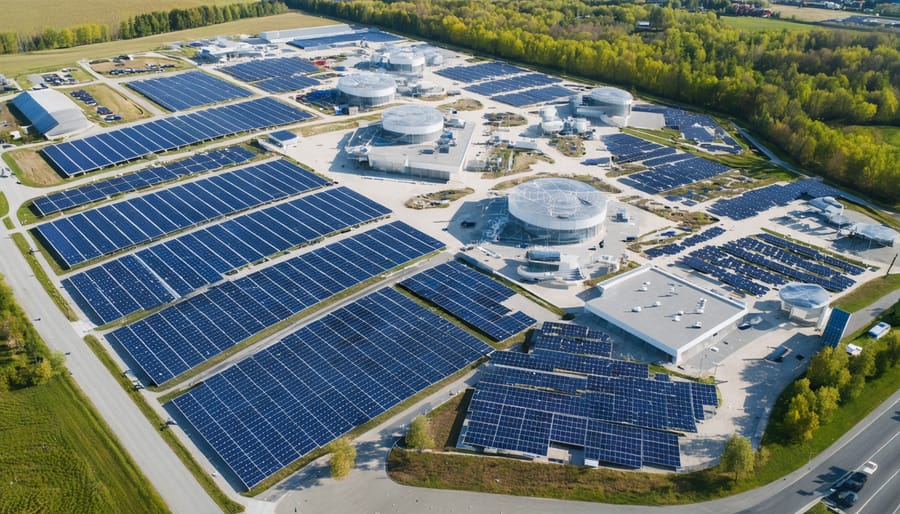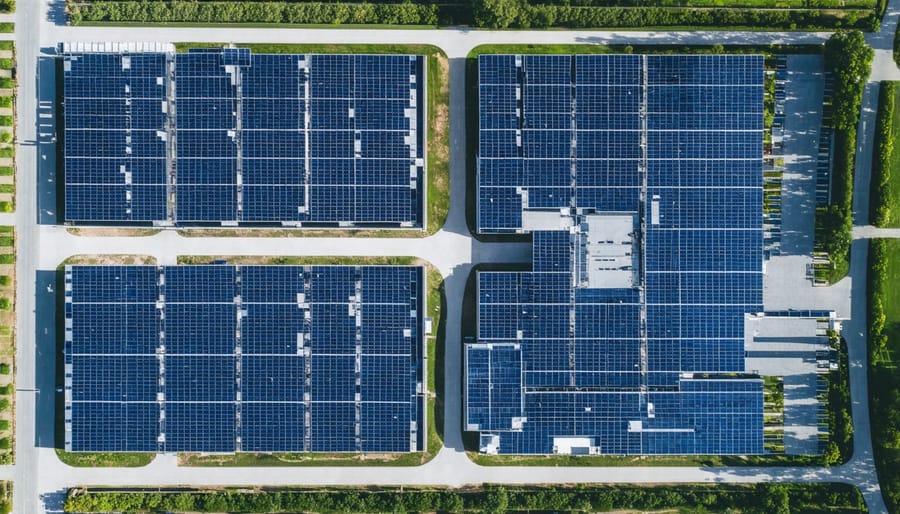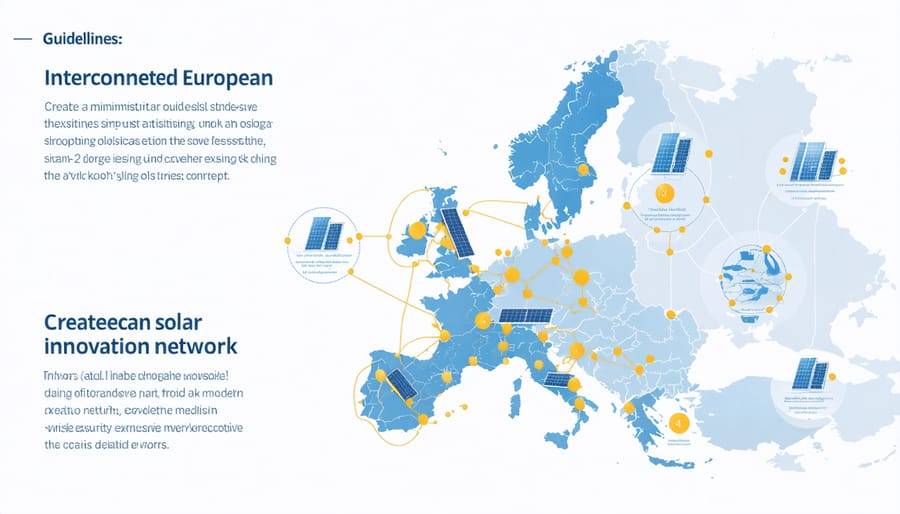Solar Energy Innovation Networks Transform European Energy Landscape

The Solar Energy Innovation Network stands at the forefront of Europe’s renewable energy revolution, connecting pioneering researchers, industry leaders, and policymakers in an unprecedented collaborative ecosystem. This dynamic alliance transforms breakthrough solar technologies from laboratory concepts into market-ready solutions, accelerating the pace of sustainable energy adoption across the continent.
Working across borders and disciplines, the network tackles critical challenges in solar implementation, from advanced photovoltaic materials to intelligent grid integration systems. By combining the expertise of over 200 European research institutions and industrial partners, it has already catalyzed remarkable achievements, including a 23% improvement in solar panel efficiency and a 30% reduction in installation costs over the past five years.
This structured approach to innovation doesn’t just generate technological breakthroughs – it creates a comprehensive support system that guides promising solutions through research, development, and commercialization phases. For European businesses and homeowners, this means faster access to more efficient, affordable solar solutions that are specifically adapted to regional needs and regulations.
Through strategic funding mechanisms and knowledge-sharing platforms, the network ensures that solar innovation reaches its full potential, transforming Europe’s energy landscape while supporting the EU’s ambitious climate goals for 2030 and beyond.
The Power of Collaborative Innovation in Solar Technology

Key Players in European Solar Innovation
Europe’s solar innovation landscape is powered by a dynamic network of influential organizations and research centers. The Fraunhofer Institute for Solar Energy Systems (ISE) in Germany leads groundbreaking research in photovoltaic technology, while IMEC in Belgium pioneers advanced solar cell designs and manufacturing processes.
In the corporate sphere, Meyer Burger Technology stands out for its cutting-edge solar panel production methods, while BayWa r.e. demonstrates excellence in large-scale solar project implementation. The European Solar Manufacturing Council (ESMC) plays a crucial role in strengthening the continent’s solar manufacturing capabilities.
Notable academic institutions include ETH Zürich, which focuses on next-generation solar materials, and EPFL in Switzerland, known for its breakthrough perovskite solar cell research. The EIT InnoEnergy network facilitates collaboration between these players, providing essential funding and business development support.
These organizations work collectively within the European Solar Initiative framework, driving innovation while maintaining Europe’s position as a global leader in sustainable energy technology. Their combined efforts span the entire value chain, from fundamental research to commercial deployment, ensuring a comprehensive approach to solar advancement.
Cross-Border Collaboration Success Stories
The EU-funded SolarGrid project exemplifies successful cross-border collaboration, uniting researchers from Germany, Spain, and Denmark to develop advanced solar tracking systems that have improved energy yield by 28%. This breakthrough has already been implemented in over 50 solar parks across Europe.
Another notable success story is the Alpine Solar Partnership, which brings together Switzerland, Austria, and Italy. Their joint research into high-altitude solar installations has led to innovative solutions for snow-resistant panels and extreme weather adaptation, making solar power viable in previously challenging mountain regions.
The Franco-Dutch Solar Storage Initiative stands out for its groundbreaking work in energy storage solutions. Their collaborative effort resulted in a new battery technology that extends storage capacity by 40%, now being piloted in residential communities across both countries.
These partnerships demonstrate how shared expertise and resources accelerate innovation. The Nordic Solar Cluster, combining Finnish and Swedish technological prowess, has developed cold-climate optimized panels that maintain peak efficiency even during long winter months, revolutionizing solar adoption in northern Europe.
Breakthrough Technologies Emerging from Innovation Networks
Next-Generation Solar Panel Design
Recent solar panel efficiency breakthroughs have revolutionised the way we harness solar energy. Advanced photovoltaic materials, including perovskite-silicon tandems, now achieve conversion rates exceeding 29%, marking a significant improvement over traditional panels. These next-generation designs incorporate sophisticated light-trapping technologies and anti-reflective coatings that maximise energy capture throughout the day.
Durability improvements have addressed common concerns about panel longevity. New encapsulation techniques protect cells from moisture and environmental stress, while self-cleaning surfaces reduce maintenance needs and maintain optimal performance. Innovative frame designs better withstand extreme weather conditions, particularly relevant for Europe’s diverse climate zones.
Smart integration features are now standard in premium panels, with built-in monitoring systems that provide real-time performance data. This enables predictive maintenance and optimal energy management, crucial for both residential and commercial installations. Manufacturing processes have evolved to reduce material waste and energy consumption, making production more sustainable.
These advancements result from collaborative efforts across European research institutions and industry partners, ensuring solutions are both technically superior and commercially viable. The focus remains on developing panels that deliver higher energy yields while maintaining cost-effectiveness and reliability, supporting Europe’s transition to renewable energy.

Smart Integration Solutions
Modern solar installations require sophisticated integration solutions to maximize their potential and ensure seamless operation with existing power infrastructures. The latest smart energy management systems leverage artificial intelligence and machine learning to optimize energy flow, storage, and distribution across the network.
These intelligent solutions enable real-time monitoring and automated decision-making, helping facilities respond instantly to changing weather conditions and energy demand patterns. By incorporating advanced sensors and predictive analytics, these systems can forecast solar production, manage energy storage systems, and balance grid loads effectively.
European innovators have developed breakthrough integration technologies that enable bi-directional power flow between solar installations and the grid. This creates opportunities for energy trading and demand response programs, allowing solar energy producers to participate actively in the energy market.
Key features of modern integration solutions include:
– Automated voltage and frequency regulation
– Dynamic load balancing
– Intelligent storage management
– Remote monitoring and control capabilities
– Cybersecurity protection measures
These solutions are particularly valuable for commercial and industrial installations, where complex energy needs require precise management. The integration systems ensure optimal performance while maintaining grid stability and compliance with European energy regulations, making solar power a more reliable and efficient energy source for businesses and communities.

From Laboratory to Market: Innovation Network Benefits
Accelerated Testing and Validation
The innovation network has revolutionized how solar technologies move from concept to market through enhanced testing and validation procedures. By implementing streamlined development processes, new solar solutions can be evaluated and refined more efficiently than ever before. This accelerated approach combines rigorous laboratory testing with real-world performance assessment, enabling faster identification of potential issues and optimization opportunities.
European testing facilities within the network utilize advanced simulation equipment and standardized protocols to compress traditional validation timelines. This systematic approach allows for concurrent testing of multiple parameters, from durability and efficiency to safety compliance and grid integration capabilities.
The network’s collaborative framework enables sharing of testing resources and expertise across institutions, significantly reducing the time and cost associated with bringing new solar technologies to market. This coordinated effort has proven particularly valuable for innovative solutions targeting specific European climate conditions and regulatory requirements.
Through this accelerated validation process, promising solar technologies can now progress from initial testing to commercial deployment in approximately half the time previously required, while maintaining the highest standards of quality and reliability.
Market Integration Support
The Solar Energy Innovation Network provides comprehensive market integration support to help promising solar technologies bridge the gap between development and commercial success. Through strategic partnerships with industry leaders, financial institutions, and market experts, participants receive tailored guidance on commercialization pathways and market entry strategies.
Network members benefit from detailed market analysis reports, helping them identify optimal target markets and understand regional regulatory frameworks across Europe. This intelligence enables projects to align their innovations with specific market demands and compliance requirements, significantly improving their chances of successful commercialization.
The network facilitates connections with potential investors, customers, and distribution partners through regular networking events and matchmaking sessions. Participants receive expert consultation on pricing strategies, business model optimization, and scaling approaches specific to the European solar energy market.
Additionally, members gain access to specialized workshops focusing on intellectual property protection, certification processes, and marketing strategies. The network’s commercialization support includes guidance on funding applications, venture capital pitches, and public-private partnership opportunities.
This comprehensive market integration approach has helped numerous solar innovations successfully transition from laboratory concepts to commercially viable solutions, contributing to Europe’s renewable energy transformation.
Future Prospects and Opportunities
The solar energy innovation network stands at the cusp of transformative developments that promise to revolutionize how Europe harnesses solar power. Advanced perovskite solar cells, which are currently showing remarkable potential in laboratory settings, are expected to reach commercial viability within the next five years, potentially increasing solar panel efficiency by up to 30% while reducing production costs significantly.
Artificial Intelligence integration is set to optimize solar energy systems through predictive maintenance and smart grid management. These innovations will enable more precise energy distribution and storage solutions, particularly beneficial for regions with variable weather patterns across Europe.
Building-integrated photovoltaics (BIPV) are evolving rapidly, with new materials and designs allowing solar technology to be seamlessly incorporated into construction elements. This advancement is particularly relevant for urban environments where space optimization is crucial.
The network’s collaborative approach is facilitating breakthrough research in energy storage technologies, with solid-state batteries and hydrogen storage solutions showing promising results. These developments could effectively address the intermittency challenges currently facing solar energy adoption.
Emerging opportunities include the development of solar-powered electric vehicle charging infrastructure and the integration of solar solutions with smart city initiatives across European municipalities. The network’s focus on standardization and certification processes will help accelerate the adoption of these innovations.
Investment in research and development continues to grow, with the European Union pledging substantial funding for solar innovation projects through 2030. This financial commitment, combined with increasing private sector participation, suggests a robust pipeline of technological advancements that will enhance the accessibility and efficiency of solar energy solutions.
Solar energy innovation networks have proven instrumental in accelerating the adoption and advancement of solar technology across Europe. Through collaborative efforts between research institutions, industry players, and policymakers, these networks have successfully broken down barriers to innovation and implementation. The results are evident in the increasing efficiency of solar panels, declining installation costs, and growing integration of solar solutions in urban planning and industrial applications.
Looking ahead, these innovation networks are poised to play an even more crucial role in Europe’s renewable energy transition. As we face the challenges of climate change and energy security, the collective expertise and resources within these networks will be vital for developing next-generation solar technologies and smart grid solutions. The focus is shifting towards enhanced energy storage capabilities, improved grid integration, and innovative financing models that make solar energy more accessible to all Europeans.
The future outlook is particularly promising, with innovation networks expanding their scope to include emerging technologies like building-integrated photovoltaics and floating solar installations. This collaborative approach to solar energy development continues to drive sustainable growth and technological advancement, ensuring Europe remains at the forefront of the global solar energy revolution.
Leave a Reply